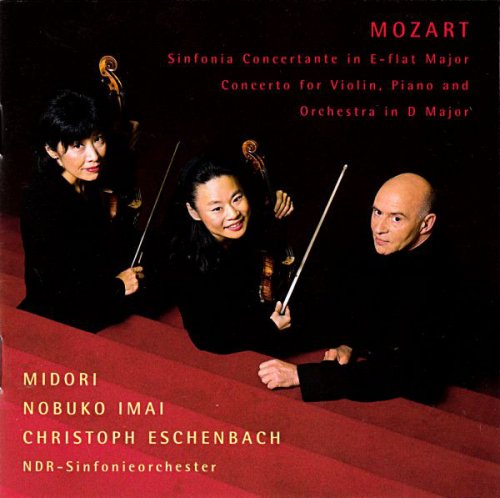
Midori, Nobuko Imai, Christoph Eschenbach - Mozart: Sinfonia Concertante, Concerto for Violin, Piano and Orchestra (2009)
BAND/ARTIST: Midori, Nobuko Imai, Christoph Eschenbach
- Title: Mozart: Sinfonia Concertante, Concerto for Violin, Piano and Orchestra
- Year Of Release: 2009
- Label: Sony Classical
- Genre: Classical
- Quality: FLAC (image+.cue,log,scans)
- Total Time: 58:34
- Total Size: 284 Mb
- WebSite: Album Preview
Tracklist:
Sinfonia Concertante in E-flat Major, K.364
1. I. Allegro maestoso
2. II. Andante
3. III. Presto
Concerto in D Major for violin and Piano, K. Anh. 56
4. I. Allegro
5. II. Andantino cantabile
6. III. Allegretto
Performers:
Midori, violin
Nobuko Imai, Viola
NDR-Sinfonieorchester
Christoph Eschenbach, conductor and piano
Sinfonia Concertante in E-flat Major, K.364
1. I. Allegro maestoso
2. II. Andante
3. III. Presto
Concerto in D Major for violin and Piano, K. Anh. 56
4. I. Allegro
5. II. Andantino cantabile
6. III. Allegretto
Performers:
Midori, violin
Nobuko Imai, Viola
NDR-Sinfonieorchester
Christoph Eschenbach, conductor and piano
An all-Mozart program, played by artists of the highest caliber, is always interesting, but this is a strange recording; it seems to focus on innovation. Even the Sinfonia Concertante, a familiar masterpiece, beloved especially for its incomparably beautiful, heartbreaking slow movement, is given a supposedly new twist: Nabuko Imai plays her part with the viola tuned a half-step higher. However, this is how Mozart wrote it, for greater technical ease and a more brilliant sound, and though many violists prefer the normal tuning, it is not a novelty. Moreover, Midori asserts that matching the retuned viola required changes in her own fingerings, but the part is so difficult that the choice is very limited. Besides, the two soloists primarily engage in conversation, coming together only at strategic, intense moments and in Mozart's own cadenzas, so the differences are not apparent to the naked ear. The playing on all hands is brilliant and expressive, though rather fussy, with a lot of artificial dynamic changes and echo effects.
The other concerto is a "reconstruction" by Philip Wilby (who is not further identified in the booklet) of a 120-bar fragment he believes Mozart planned to use for a violin and piano concerto, along with material from a Sonata for the same instruments he had written shortly before, now known as K. 306. Wilby actually composed a rather long first movement based on Mozart's fragment and simply orchestrated the second and third movements of the Sonata. Unfortunately, Mozart's fragment seems undistinguished melodically, harmonically, and rhythmically, and Wilby's "completion" is naturally rather primitive, with some happy moments and some unhappy modulations. The Sonata, on the other hand, was Mozart's first great work in that form, and the contrast between the "real" and the "reconstructed" Mozart proves that his style can be imitated but not reproduced. Again, the performance by all concerned is excellent. -- Edith Eisler
The other concerto is a "reconstruction" by Philip Wilby (who is not further identified in the booklet) of a 120-bar fragment he believes Mozart planned to use for a violin and piano concerto, along with material from a Sonata for the same instruments he had written shortly before, now known as K. 306. Wilby actually composed a rather long first movement based on Mozart's fragment and simply orchestrated the second and third movements of the Sonata. Unfortunately, Mozart's fragment seems undistinguished melodically, harmonically, and rhythmically, and Wilby's "completion" is naturally rather primitive, with some happy moments and some unhappy modulations. The Sonata, on the other hand, was Mozart's first great work in that form, and the contrast between the "real" and the "reconstructed" Mozart proves that his style can be imitated but not reproduced. Again, the performance by all concerned is excellent. -- Edith Eisler
Classical | FLAC / APE | CD-Rip
As a ISRA.CLOUD's PREMIUM member you will have the following benefits:
- Unlimited high speed downloads
- Download directly without waiting time
- Unlimited parallel downloads
- Support for download accelerators
- No advertising
- Resume broken downloads


